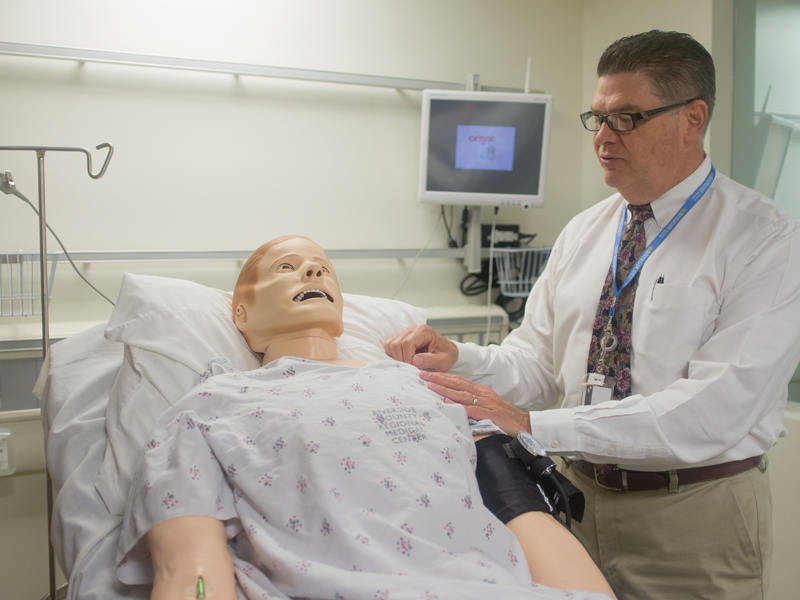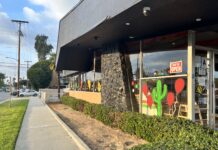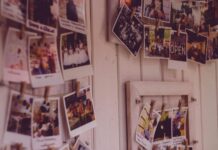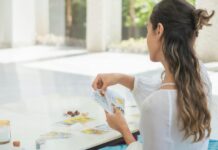
Every human body is made up of hundreds of individual parts that work in unison to help it breathe, speak and move. The heart, for instance, pumps blood throughout the body. The brain is what directs the body to act. And the corresponding central nervous system sends signals to the body from the brain, helping make those actions possible.
The UC Riverside School of Medicine (SOM) — which will wrap up its first full year in session this June — works in a similar manner. It needs a figurehead (the dean) to lead and organize it, a central nervous system (the staff) to carry out the directions of the head and a heart (the students) to pump life into the body (the school).
The Body
The school’s education building, its research building and Webber Hall are the three buildings that make up the School of Medicine. From the outside, they look like any regular old college building, complete with bricks, concrete, metal and glass. But the inside of the buildings, however, contains a treasure trove of biomedical goodies.
Inside the education building, for instance, are simulation laboratories and patient examinations rooms where aspiring doctors can train to perform diagnostics. The labs come with simulation mannequins which aid in the training process. The mannequins, which cost as much as “a small house,” according to the staff, can simulate breathing, sweating and even coughing. A student in training can even examine the life-sized dummy’s pulse and eye lenses to check for any signs of ailment.
Two lecture halls and a few discussion rooms also reside inside the education building. And just across campus is the school’s research building, where state-of-the-art facilities are used to help contribute to biomedical and health-related research. And lastly, Webber Hall is the structure that houses the labs and offices of some of the current faculty of the school.
The Brain
The part of the body that makes the actions possible; it’s the decision maker. At the School of Medicine, this is Dean Richard Olds.
When he was hired as the founding dean four years ago, he was given a nearly impossible task: Help start the first public medical school in Southern California in over four decades.
“Four years ago … the challenge was to go from a two-year school to a four-year school,” he reminisced, referring to the fact that UCR was formerly a part of the Thomas Haider program, a program where students would receive their first two years of medical training at UCR before transferring to and ultimately graduating from UCLA’s School of Medicine.
Through Olds’ leadership, UCR’s SOM managed to collect the $100 million needed to bring the four-year program to life. With the help of the state, the district supervisors and even former Chancellor Tim White, Olds recalls that the school accumulated the sufficient funding just three days before the deadline they were given to do so. Not too long after, the school received accreditation, and in the summer of 2013, the school welcomed its inaugural class of 50 medical students.
And now, Olds says he not only acts as the students’ dean, but as one of their professors. “One of the advantages of (the school) being so small is I’m also their faculty member. I actually teach them!” he said enthusiastically.
“I, as the dean, should teach them professionalism,” he went on. According to him, professionalism is a life skill that should be taught from the top figure of the school. And alongside that, he says he acts as the unofficial counselor for students, recommending what decisions to make as they begin their careers in the field of medicine. Because after all, the body does what the mind says.
The Central Nervous System
Without the nervous system, the brain wouldn’t be able to communicate with the body. At the School of Medicine, the same is true for the functioning relationship between the dean and the school’s staff and faculty.
Standardized Patient Program Director Amanda Lockhart, for one, helps train the future physicians at the patient examination rooms. There, the students train with standardized patients, which are everyday people who are hired to replicate different illnesses or maladies. Others, such as Programmer Analyst Ariel C. DeGuzman Jr. and Chris Miller help students in the simulation laboratories, assisting them in their ongoing patient diagnostic training.
And alongside them are dozens of other specialists working together as one to help the school function. Professors, researchers and former doctors with medical experience from all over the world all contribute to the school’s mission to train some of the best health professionals in the Inland Empire.
The Heart
The organ that pumps life to the body. And like a human heart, the SOM’s inaugural class of 2017 is what truly animates the school.
Just 10 months ago, the school welcomed its inaugural class in front of a cheering crowd of 700 attendees at the first-ever White Coat Ceremony. During the celebration, the inaugural class walked up to a stage in the Student Recreation Center, shook hands with the dean and ultimately slipped into their white physician coats.
“For me it was the whole path: Everything from being an undergrad and doing everything to get into medical school and then finally receiving the white coat, it was one of those things that — it was just — you made it,” said medical student Luis Contreras.
And now, nearly a year later, the students are wrapping up their first year at the school. For the past 10 months, their education has been composed of lectures, training and research. And the kicker: They have to do this about eight hours a day, five days a week.
But according to the students, it’s absolutely worth it. “You know, you put so much time and effort to apply to med school, to take your pre-reqs, to take o-chem … you’re stuck in those labs and you’re like, ‘Why am I doing this?’ But … now I know,” concluded student Trina Mansour.
Conclusion
The body of the School of Medicine has just celebrated first year of existence. And like a child, it will only continue to mature, healthy and strong.








